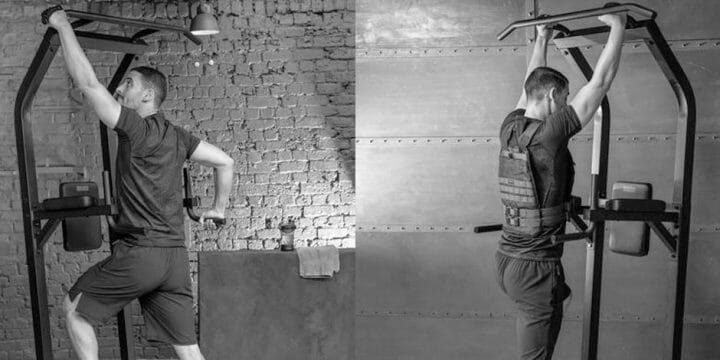In my coaching career, I’ve rarely met clients or even fitness enthusiasts who knew what the psoas muscle is, where it's located, and especially how important it is.
I always include exercises for this hidden muscle in workout plans I design since it plays a vital role in everyday movements.
In this article, I'll be sharing the psoas exercises that have turned out to be the most effective for my clients while also providing the fastest results.
Quick Summary
- The most effective psoas strengthening exercises are the low-impact ones, which are easy to perform, such as knee raises.
- Stretching this muscle is also important, so incorporating exercises like the table stretch should be part of your daily routine.
- According to a study from the International Journal of Environmental Research and Public Health, overstretching can have the opposite effect, interfering with your psoas muscle function and potentially causing posture problems.
- This hip flexors muscles group is crucial for every movement (that involves the hip joint's bending) and for maintaining proper posture.
Six Most Effective Psoas Exercises

There are over 20 psoas exercises that I have tried alone, but not all of them are equally efficient.
This paradox of choice can be challenging, so I've narrowed the number down to six exercises that have always given the best results to my clients, regardless of their fitness level.
I've arranged these exercises from the easiest to the most difficult.
1. Knee Raises
This exercise strengthens the psoas muscles by actively flexing the hip joint and engaging the core to stabilize your body.
This standing hip flexion with knee raises represents good practice for beginners as it can be performed without any equipment.
Here’s how you do this exercise:
- Stand up straight and bring one knee towards your chest, lifting your heel off the ground and bending it to 90 degrees.
- Hold for several seconds.
- Repeat with the other leg.
 2. Frankenstein Walk
2. Frankenstein Walk
This simple exercise is a popular part of many cardio warmups, but it's also effective for working the psoas muscles.
Here’s how you do this exercise:
- Stand upright with good posture and hands hanging at your sides.
- Kick one leg straight up as high as you can so you can touch the tips of your toes with the opposite hand. The two should meet midair.
- Step forward and repeat the movement with alternative limbs, maintaining a neutral back.
3. Leg Lifts
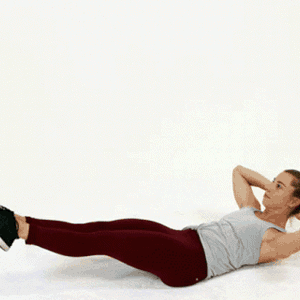
This exercise can come in several difficulty levels, but here's how to do the simplest version:
- Lay on your back, keeping your chest up to maintain good posture.
- Engage your core and lift your legs, keeping the knees straight.
- Start lowering the right leg slowly until it almost touches the floor.
- Bring it back up and do the same with the left leg.
 4. Bridges
4. Bridges
By tweaking the steps just a bit, you can tailor this popular glute exercise to work the psoas muscles.
Here’s how you do this exercise:
- Lie flat on your back as you would for a standard bridge (knees bent and feet flat on the ground).
- Lift your hips slightly off the ground, squeezing your glutes and engaging your core.
- Hold this position for a few seconds.
- Lower the hips back down to the starting position in a slow and controlled manner.
5. Lunges
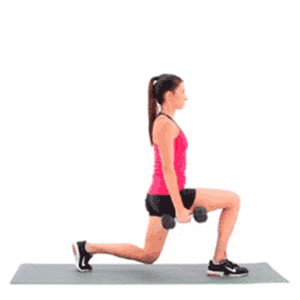
When done correctly, this common leg exercise can become a great way to strengthen the psoas muscle.
To target it, you should perform this exercise more as a stretch than a strengthening movement.
Here’s how you do it:
- Take a big step forward with one leg and bend both knees.
- Lower your back knee to touch the floor or keep it hovering just above the floor.
- Hold this position for a few seconds, then push back up to the starting position.
- Repeat on the other leg.
 6. Hanging Leg Raise
6. Hanging Leg Raise
This advanced exercise requires a certain upper body and core strength.
Therefore, it's important to gradually build up to it and use proper form to avoid injury.
Here’s how you do this exercise:
- Hang from a pull-up bar high enough, with arms fully extended, so your feet don't touch the ground.
- Keep your legs straight by using your abdominal muscles and hip flexors (not momentum) to lift your legs toward your chest.
- Hold for a moment at the top.
- Slowly lower your back down to the starting position.
Do as many repetitions of each exercise as you feel comfortable with. After performing these exercises, it's important to cool down and stretch the muscles.
How To Stretch This Muscle

To stretch this muscle, you need to loosen and lengthen it every day gently.
Fortunately, these stretches are simple and can be done quickly. Here are two of the most effective ones for tight psoas muscle.
1. Table Stretch
Here’s how you do this stretch:
- Lie on the bed, bench, or sturdy table, and let your right leg hang over the edge.
- Hold for a few seconds. Switch legs and repeat the movement.
2. Frog Stretch
Here’s how you do this stretch:
- Lie on your stomach with your legs behind you.
- With your knees bent at 90 degrees, lift your upper body to your elbows.
- Keep your calves parallel to the floor as if doing a split.
In addition to these specific exercises, incorporating various yoga poses such as king dancer, tree pose, wheel pose, and camel pose, as well as lunge movement variations such as the back bending lunge, low lunge, and leaning upright lunge, can be very helpful.
However, to avoid overstretching, it's important to gradually increase the number of repetitions and time under tension as your flexibility improves.
According to a study from the International Journal of Environmental Research and Public Health, overstretching can have the opposite effect, interfering with your psoas muscle function and potentially causing posture problems [1].
Related Article: Types of Pre Workout Stretches
Why It’s Important to Take Care Of This Muscle?
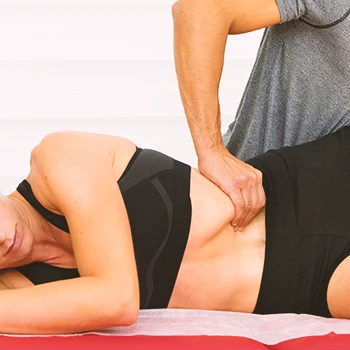
It's important to take care of the psoas muscle because a strong and healthy psoas allows for greater ease of movement and better posture.
On the other hand, a weak and tight psoas can pull vertebrae down and forward, resulting in stiffness and low back pain.
Despite playing a significant role in everyday movements and posture, its specific location in the body causes many to neglect it and risk potential issues.
What Exactly Constitutes Psoas?
The psoas is a muscle group (also known as the iliopsoas muscles) made up of three individual muscles: the psoas major, psoas minor, and iliacus.
The group lies deep within your core and acts as a primary connector of the torso and legs (connecting the lumbar spine to your thigh bone).
The psoas muscles (primary hip flexors) are responsible for contractions resulting in movement (or bending) in the hips and lower body. They stabilize your lower back and are activated anytime you walk, sit, or bend down [2].
"The psoas muscle is very important for movement and stability of the low back and pelvis. It is often involved in low back and pelvic pain, especially in those who sit a lot or have a history of trauma."
- Dr. Amy Konvalin, Physical Therapist
When shortened or tight (by poor posture, stress, or excessive exercise), this muscle group can cause issues like anterior pelvic tilt or lordosis of the lumbar vertebrae (a pronounced inward curve of the lower back).
The weak psoas might also be a culprit for low back pain and pain in your knees, hamstrings, or hip joints [3].
What Benefits Does a Strong Psoas Bring?
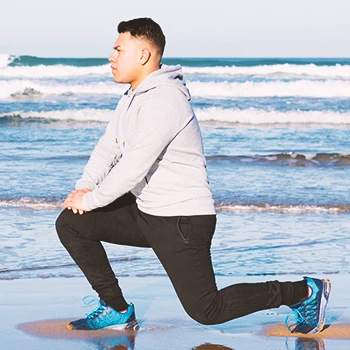
Strong psoas muscle can bring several benefits, such as reduced lower back pain, improved hip mobility, and better athletic performance.
Since it's involved in many movements like running, jogging, and lifting a strong and flexible psoas can help improve athletic performance and reduce the risk of injury.
Besides athletic performance, healthy psoas muscle allows you to walk and stand upright with a proper posture since your lumbar curve bears and transfers the weight above it [4].
In addition to supporting strong muscular function, these hip flexors also help several internal organ functions, resulting in a healthier body overall.
Exercises for Strengthening the Psoas in Older Adults
As we age, our muscles naturally lose strength and flexibility, and the psoas muscle is no exception. This crucial muscle, connecting the lower spine to the femur, plays a vital role in hip flexion, posture, and lower body mobility.
With age, a weakened psoas can lead to a range of issues, including lower back pain, posture problems, and reduced mobility.
To fight the effects of aging psoas muscles, here are some exercises I recommend to clients above the age of 50:
- Seated leg lifts: Performed while sitting on a chair, lifting one leg at a time helps in gently strengthening the psoas without strain.
- Standing knee raises: Holding onto a chair for support, this exercise involves raising one knee at a time, mimicking a marching motion. It's effective for both strengthening and improving balance.
- Supine pelvic tilts: Performed lying on the back with knees bent, this exercise involves tilting the pelvis and flattening the back against the floor, engaging the psoas and core muscles.
- Gentle stretching: Incorporating gentle stretching exercises, like the kneeling hip flexor stretch, can maintain flexibility in the psoas and prevent stiffness.
FAQs
Should You Massage the Psoas Muscle?
You should massage the psoas muscle from time to time since massage can help release tension and promote relaxation in the muscle. It’s important to work with a qualified massage therapist who has experience with deep tissue work.
Is Walking Good for the Psoas Muscle?
Yes, walking can be good for the psoas muscle. It’s a low-impact exercise that reduces the risk of muscle imbalances which can cause psoas tightness or weakness. However, to strengthen the psoas adequately, it’s important to ensure that you are using the proper walking form and technique to avoid straining the muscle.
References:
- https://www.mdpi.com/1660-4601/18/4/1936
- https://www.physio-pedia.com/Psoas_Major
- https://www.ncbi.nlm.nih.gov/books/NBK551701/
- https://clinmedjournals.org/articles/ijsem/international-journal-of-sports-and-exercise-medicine-ijsem-3-062.php
About The Author
You May Also Like



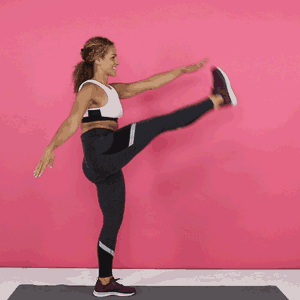 2. Frankenstein Walk
2. Frankenstein Walk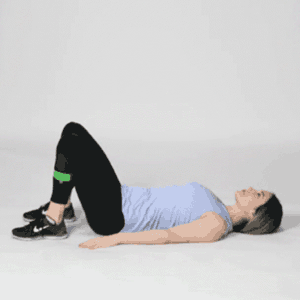 4. Bridges
4. Bridges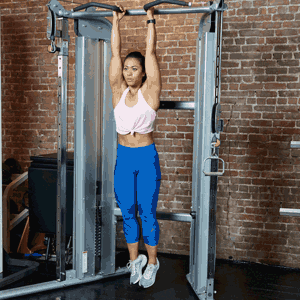 6. Hanging Leg Raise
6. Hanging Leg Raise
